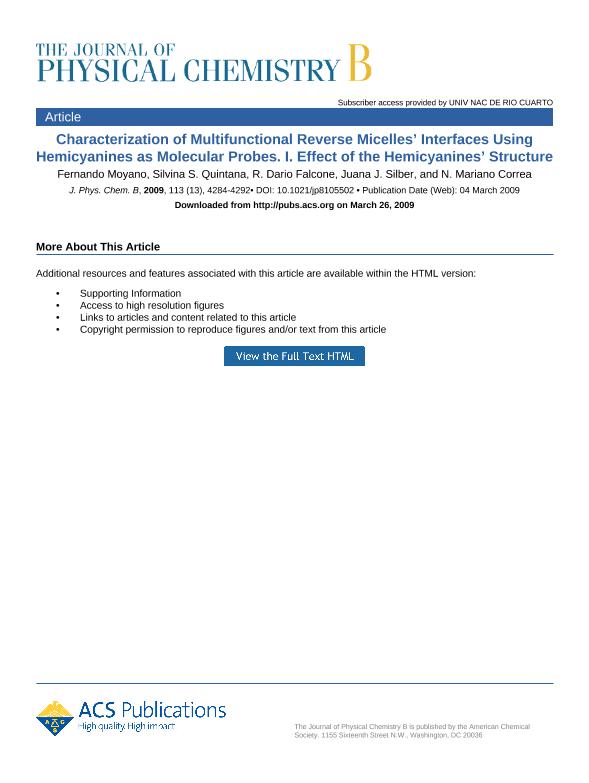Mostrar el registro sencillo del ítem
dc.contributor.author
Moyano, Fernando

dc.contributor.author
Quintana, Silvina S.
dc.contributor.author
Falcone, Ruben Dario

dc.contributor.author
Chessa, Juana Josefa

dc.contributor.author
Correa, Nestor Mariano

dc.date.available
2020-09-17T17:11:49Z
dc.date.issued
2009-04
dc.identifier.citation
Moyano, Fernando; Quintana, Silvina S.; Falcone, Ruben Dario; Chessa, Juana Josefa; Correa, Nestor Mariano; Characterization of multifunctional reverse micelles' interfaces using hemicyanines as molecular probes: I. effect of the hemicyanines' structure; American Chemical Society; Journal of Physical Chemistry B; 113; 13; 4-2009; 4284-4292
dc.identifier.issn
1089-5647
dc.identifier.uri
http://hdl.handle.net/11336/114225
dc.description.abstract
In this work, we report the behavior of two different hemicyanines, trans-4-[4-(dimethylamino)styryl]-Nmethylpyridinium iodide (HC) and 4-[4-(dihexadecylamino)styryl]-N-methylpyridinium iodide (DIA), in water/ sodium 1,4-bis-2-ethylhexylsulfosuccinate (AOT)/benzene reverse micelles media using absorption and emission spectroscopy in addition to the steady-state and time-resolved fluorescence emission techniques. Our results show that the AOT reverse micelles interface has the nontrivial deaggregation property, a result that may have potential application for the preparation of dye lasers, which require a noninteracting monomeric form of the dye. Also, we show that the water interacts with a different region of the AOT moiety depending on the external organic solvent used and, in addition, we also present a nice, simple, and noteworthy method that helps to examine the presence or the absence of organized media. In conclusion, our results show that HC and DIA are powerful dyes to characterize simultaneously different interfaces' properties as they can be used to sense, at the same time, fluidity and specific interactions at the interface. These results are important because those properties are the key for molecular recognition.
dc.format
application/pdf
dc.language.iso
eng
dc.publisher
American Chemical Society

dc.rights
info:eu-repo/semantics/openAccess
dc.rights.uri
https://creativecommons.org/licenses/by-nc-sa/2.5/ar/
dc.subject
reverse micelles
dc.subject
AOT
dc.subject
Hemicyanines
dc.subject
emission spectroscopy
dc.subject.classification
Físico-Química, Ciencia de los Polímeros, Electroquímica

dc.subject.classification
Ciencias Químicas

dc.subject.classification
CIENCIAS NATURALES Y EXACTAS

dc.title
Characterization of multifunctional reverse micelles' interfaces using hemicyanines as molecular probes: I. effect of the hemicyanines' structure
dc.type
info:eu-repo/semantics/article
dc.type
info:ar-repo/semantics/artículo
dc.type
info:eu-repo/semantics/publishedVersion
dc.date.updated
2020-09-08T14:04:30Z
dc.identifier.eissn
1520-6106
dc.journal.volume
113
dc.journal.number
13
dc.journal.pagination
4284-4292
dc.journal.pais
Estados Unidos

dc.journal.ciudad
Washington
dc.description.fil
Fil: Moyano, Fernando. Universidad Nacional de Río Cuarto; Argentina. Consejo Nacional de Investigaciones Científicas y Técnicas; Argentina
dc.description.fil
Fil: Quintana, Silvina S.. Universidad Nacional de Río Cuarto; Argentina
dc.description.fil
Fil: Falcone, Ruben Dario. Consejo Nacional de Investigaciones Científicas y Técnicas; Argentina. Universidad Nacional de Río Cuarto; Argentina
dc.description.fil
Fil: Chessa, Juana Josefa. Universidad Nacional de Río Cuarto; Argentina. Consejo Nacional de Investigaciones Científicas y Técnicas; Argentina
dc.description.fil
Fil: Correa, Nestor Mariano. Universidad Nacional de Río Cuarto; Argentina. Consejo Nacional de Investigaciones Científicas y Técnicas; Argentina
dc.journal.title
Journal of Physical Chemistry B

dc.relation.alternativeid
info:eu-repo/semantics/altIdentifier/url/https://pubs.acs.org/doi/10.1021/jp8105502
dc.relation.alternativeid
info:eu-repo/semantics/altIdentifier/doi/http://dx.doi.org/10.1021/jp8105502
Archivos asociados
